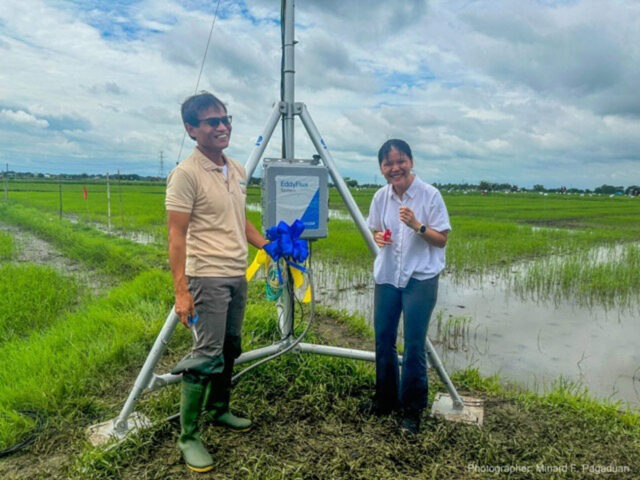SCIENCE CITY OF MUÑOZ (PIA) — The Philippine Rice Research Institute (PhilRice) and the Philippine Space Agency (PhilSA) have partnered to integrate ground-based and satellite technologies in advancing climate-smart and sustainable rice farming.
Under a signed Memorandum of Agreement, the two agencies will jointly operate an eddy covariance flux tower installed at the PhilRice Central Experiment Station in Nueva Ecija.
PhilRice researcher and project leader Elmer Alosnos explained that the project aims to make rice farming as part of the solution to climate change, serving not only as a food source but also as a model for sustainable and climate-resilient agriculture.
The tower is capable of collecting data on greenhouse gases (GHG), including carbon dioxide and methane, as well as monitoring energy and water vapor exchanges between rice fields and the atmosphere.
“This gives us a more accurate way to monitor GHG emissions from rice fields. I believe this makes us one of the most high-tech institutions in the country,” PhilRice deputy executive director for research Eduardo Jimmy Quilang said.
By combining satellite-derived data with on-ground information, the initiative will strengthen decision-making for rice production, GHG monitoring, and long-term environmental research.
The information gathered will also feed into the Philippine Rice Information System (PRiSM), PhilRice’s satellite-based rice monitoring platform, to support the development of climate-smart farming practices that benefit farmers, researchers, policymakers, and climate experts.
According to the agreement, PhilSA is responsible for installing, calibrating, and processing data from the tower and conducting research through combined satellite and ground-based data to understand how rice ecosystems interact with the environment.
Meanwhile, PhilRice will oversee daily operations and utilize the data to enhance PRiSM, which monitors rice areas, forecasts yields, and assesses crop damage.
The data collected by PRiSM will also help validate satellite images captured by PhilSA’s Multispectral Unit for Land Assessment (MULA) satellite under the SatMAPPER-SOPRAnO project, which aims to monitor land conditions.
“This partnership is a significant step toward sustainable agriculture in the Philippines. This flux tower will measure the GHG exchanges, supporting PhilRice’s PRiSM project that uses remote sensing and geographic information system technologies to monitor rice areas and assess crop production,” PhilSA-Space Science Missions Bureau Director IV Reinabelle Reyes explained.
The five-year partnership includes collaborative research, training, and capacity-building activities to maximize the long-term utilization of the tower.
Both agencies are committed to responsible data sharing and co-ownership of any resulting intellectual property, marking a milestone in advancing climate-smart agriculture in the country. (CLJD/CNG, PIA Region 3-Nueva Ecija)





